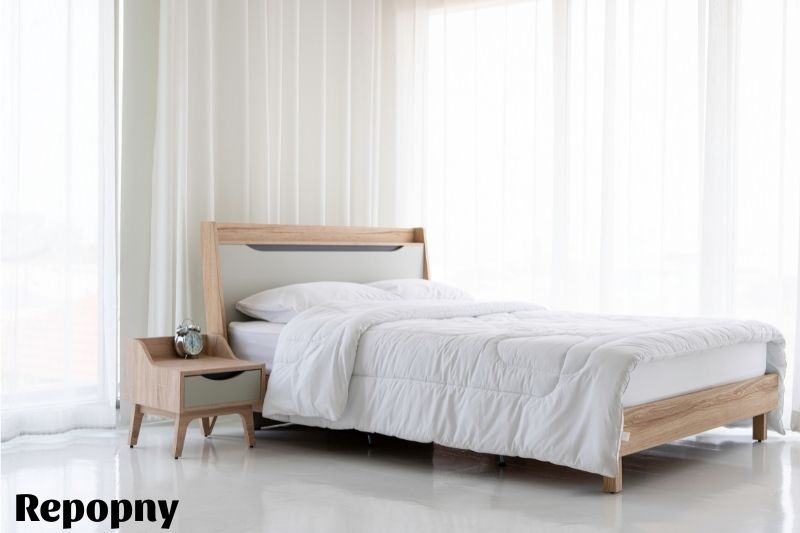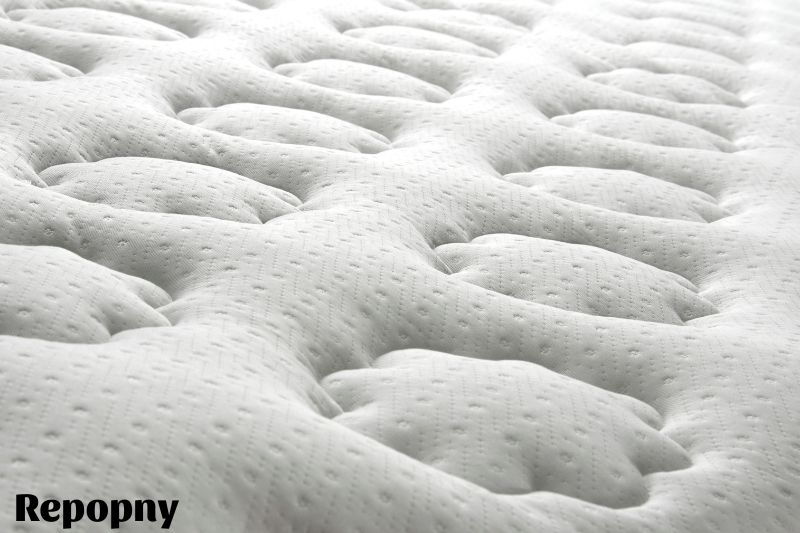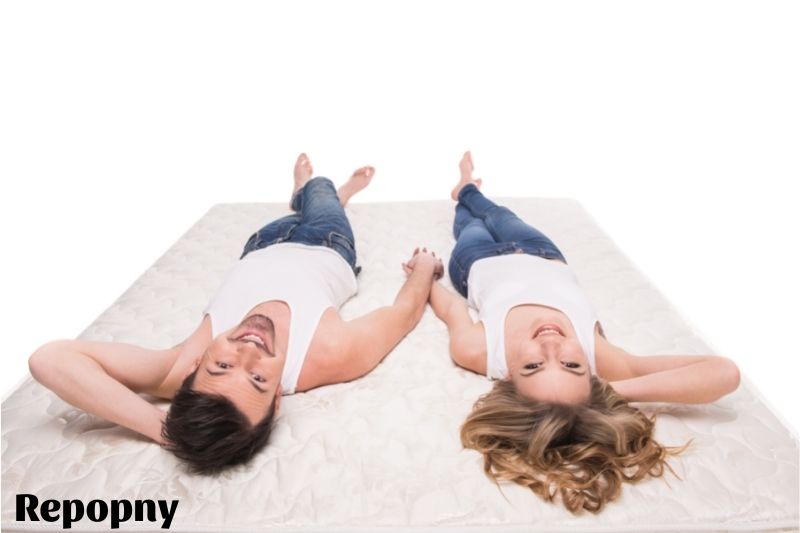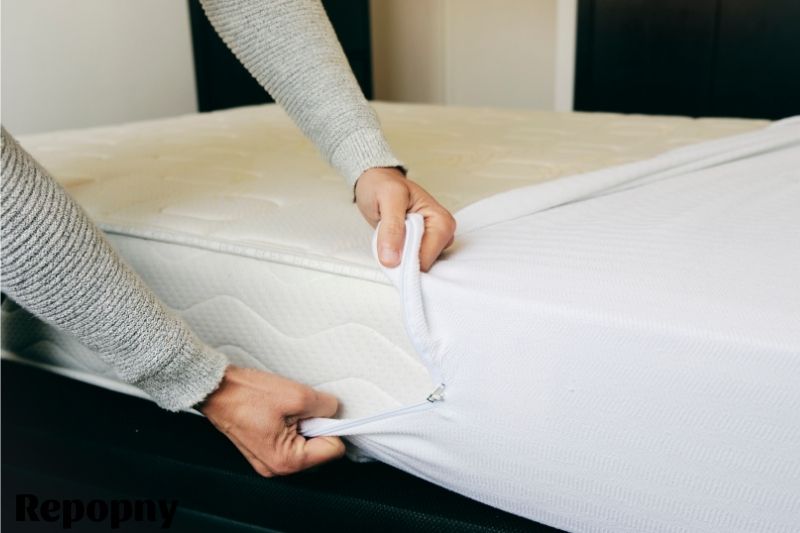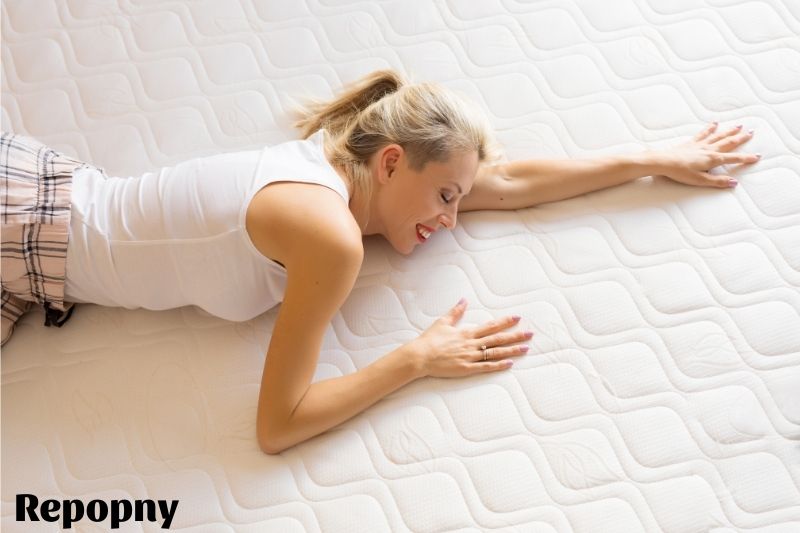- Repopny
A mattress is an investment that you hope will last for years, but how long does a mattress last? The answer may surprise you.
Depending on the type and how well you take care of it, a mattress can last anywhere from 5 to 10 years. But you can do a few things to help your mattress last even longer. In this article, Repopny will provide you with some tips to protect it.
Contents
How Long Does A Mattress Last: At A Glance
Although mattresses come in various materials, memory foam, hybrid, latex, and innerspring are most common. Each array will have a slightly varied lifespan. Here’s a quick rundown of how long each mattress typically lasts:
- Latex has a lifespan of 15 to 25 years.
- 8-10 years for memory foam
- 7 to 10 years (hybrid)
- 5–7 years in the innerspring
Consider investing in one of the best mattress toppers if you’re still sleeping well in your bed, but it is over five years old or needs a little boost in terms of comfort or support. If you choose the appropriate one, you’ll be able to sleep in your current bed for a few more years.
How Long Does A Memory Foam Mattress Last?
Memory foam is pretty long-lasting, with an expected eight to ten years. This is because these mattresses have fewer materials and components, making them less likely to decay and impair quality.
Memory foam mattresses should be turned on regularly and kept clean and ventilated. It’s time to upgrade if you begin to wake up with aches and pains and discover that the foam no longer supports you or provides pressure relief.
A red sign is a sink-in body cradling that has gone from sublime to absurd. Keep an eye out for memory foam discoloration (yellowing), a symptom of a mattress’s age.
How Long Does A Latex Mattress Last?
Latex is the most durable of all the materials so latex mattresses will last the longest. This is only true if you get a 100 percent natural latex mattress, lasting anywhere from 15 to 25 years. When shopping for a latex bed, look for names like organic, Dunlop, or Talalay.
They are sometimes more expensive. However, this is offset by the fact that they last longer. The latex that is blended or synthetic has five to ten years. It also softens faster than natural latex and has the potential to off-gas.
How Long Does A Hybrid Mattress Last?
Although hybrid models aren’t as long-lasting as memory foam, you may still anticipate using them for several years. Due to the high-quality materials used, several brands, like Purple and Casper, claim that their hybrid mattresses can last up to ten years.
Because hybrid beds have more layers and components than most other beds on the market, they are more prone to premature sagging, resulting in a slightly shorter average lifespan.
Hybrids should be rotated regularly but not flipped unless the manufacturer specifies otherwise. This is because they usually have a soft top and a firm foundation. If you turn a hybrid mattress that wasn’t supposed to be flipped, you risk voiding the guarantee.
How Long Does A Innerspring Mattress Be Last?
Innerspring mattresses have a lifespan of about five to seven years since the springs break out over time and can cause sagging. However, they are trendy because of their bounce, comfort, and lower price tags.
Of course, this can be a waste of money because you’ll have to replace it more frequently. If you insist on having an innerspring bed, search for one with an extra layer of coils and a soft cushion top for more comfort.
Factors Affecting Mattress Durability
While the general rule is that mattresses should last 7 to 10 years, not all will withstand the test of time. Several factors: determine the lifespan of mattresses.
Materials: The materials used in manufacturing will have a significant impact on its longevity. Latex and high-density polyfoam materials can endure a long time, whereas low-density polyfoam wears out considerably faster.
Original Quality: The quality when you first purchase it will affect how long it lasts. A low-cost, entry-level will wear out far faster than a high-end hybrid mattress. While a more significant price tag does not always imply a higher-quality product, the more expensive mattresses often have a higher quality structure and last longer.
Mattress Type: Are you sleeping on an all-foam, hybrid, latex, or innerspring mattress? The type you choose can significantly impact how long it lasts. Latex mattresses have the most extended lifespan, followed by high-density memory foam or polyfoam beds. Lower-density foam beds, as well as hybrid types, wear out more quickly. Traditional innerspring mattresses have the shortest life expectancy, ranging from five and a half to six and a half years.
Sleep Position & Body Weight: How soon it wears out is affected by the position you sleep in and your body weight. Mattresses may sag prematurely for heavier sleepers, while side-sleepers may have significant sagging around the hips and shoulders.
Care Routine: As with other things in life, taking care of this product will extend its life. Cleaning your mattress regularly, using protective coverings, and following the manufacturer’s care instructions are all part of proper mattress care. Some mattresses can be rotated or routinely flipped, but verify the manufacturer’s instructions first.
The table below outlines the most common mattress kinds’ performance and durability ratings.
How To Care For Your Mattress So It Last Longer
Following a few essential tips will help you extend the life of mattresses, saving you money in the long term because you won’t have to replace them as frequently:
1. Rotate it frequently to keep the surface even and avoid indents. Although particular mattresses can be flipped, always read the manufacturer’s instructions first. Some mattresses are just one-sided and may be harmed if they are turned.
2. Place it on a solid foundation. Most manufacturers specify which bed bases are best for particular mattresses, but a box spring, platform, or bed frame with regularly spaced slats should give adequate support.
3. Keep your bed fresh by cleaning and airing it regularly. Many modern mattresses feature removable and machine-washable covers; however, some can only be spot-cleaned. Vacuum your mattress and wash your bedding regularly to help prevent dust mites, germs, and sweat from accumulating.
4. Always use a mattress protector. These cover your bed like a fitted sheet and protect it from dirt, spills, sweat, and bacteria. They’re simple to machine wash and dry, and they don’t have to be expensive.
9 Signs Your Mattress Needs to Be Replaced
Sagging
Sagging and deep grooves and indentations are the most evident signs that your cherished mattress has to be replaced.
This is especially true if you sleep on one side of the bed more than the other. It should ideally be flat and firm, with no visible dips or craters.
Your best firm mattress should provide adequate support for your back and spine when you sleep. To help with some of the sagging, you may acquire a foam topper. You can also flip your product over to correct sagging.
This is particularly true when it comes to innerspring mattresses. However, this is only a temporary solution; you will eventually need to buy a new one.
Stains and Odors That Won’t Go Away
Accidents are unavoidable when you share your bed with a youngster or a pet. You’ll have to deal with inevitable food spills and toilet training blunders.
Such mishaps may not even permeate your mattress if you have enough protection, such as a liner or a cover.
At some point, all mattresses will show indications of use. This could include stains and odors that refuse to go away despite your best efforts.
When you discover it in this state, it’s time to remove it and replace it.
Donate your old one to an animal sanctuary or recycle it at a mattress recycling center.
Infestation with bedbugs
Bed bug infestations are sometimes unavoidable, no matter how rigorous you are about hygiene and sanitation. If you travel overseas frequently, your home may be particularly exposed.
Bed bug infestations are most commonly found under walls and floorboards, couch cushions, pillows, linen closets, and mattresses.
If you find these pests in your bed, it’s time to replace the mattress and fumigate the entire house.
It doesn’t imply they aren’t there because you can’t see them. When sleeping, bed bugs will crawl out of their hiding spots.
You may have bedbugs if you wake up with unexplained red marks on your body.
It’s time to get a new product; a mattress protector won’t suffice.
Bumpy and Lumpy
The lumpiness isn’t supposed to be present in a mattress. Run your hands along with your mattress and feel for lumps and rolls, especially on the spots you tend to favor.
This happens to all mattresses over time. On the other hand, a bumpy mattress will not provide adequate back support.
Don’t sleep on a bumpy mattress for longer than necessary for a good night’s sleep and optimal comfort. Invest in a high-quality mattress with high-density foam to extend the life of this product.
Asthma or Allergies
No matter how often you wash, clean, and vacuum your mattresses, dust mites will always be present.
Dust mites can number anywhere from 100,000 to 10 million in an ordinary mattress.
Aside from dust mites, it is a breeding ground for mold and mildew, two frequent allergens. Pillows are yet another allergy hotspot.
Your pillows should be replaced once a year. When was the last time you had your pillows replaced?
Your Mattress Is More Than Seven Years Old
If it has been in your home for more than seven years, it may be time to evaluate its comfort level and consider replacing it.
You may make an exception if it’s in a spare bedroom that’s rarely used.
Tip: To extend the life of a mattress, keep it covered while not in use.
Creaks and Squeaks
Although it may not squeak, a box spring bed base can become squeaky and creaky.
The wear and tear of the coils inside cause this. Most mattresses and box spring bed bases are offered as a set. However, you will almost certainly need to replace it before the bed base.
However, the bed base should not be overlooked. Check if the surface is still stable, if the base is more than seven years old or has a lot of wear and tear.
Aches and Pains or Discomfort
Your bedroom, particularly your bed, should be a haven of comfort and relaxation.
According to studies, a comfortable mattress is necessary for a good night’s sleep.
If you’re having trouble sleeping, it’s possible that your mattress is to blame.
Out With the Old in With the Nectar!
Perhaps your mattress is relatively fresh and in the decent condition right now. That, however, is subject to change. Life events such as marriage or moving in with someone and sharing a bed can put you in the mood for a new beginning. Purchasing a new one may assist you in adjusting to this new stage because a good night’s sleep is the foundation of everything.
FAQs
Is it possible for a mattress to survive 20 years?
Particular mattresses can survive up to 20 years with careful maintenance, but this is unusual. High-quality mattresses constructed of plant-based memory or latex foam are recommended.
If your mattress has springs, make sure the coils are pocketed to respond better to movement and pressure and don’t sag.
What can I do to extend the life of my mattress?
Put a mattress protector on it as soon as possible (preferably an encasement covering all sides). If you use the wrong foundation for this product, you risk ruining it. Check with the manufacturer to see what foundations they recommend.
When is a mattress no longer fit for purpose?
Within 7-10 years, most mattresses begin to sag. It may be time for a new mattress if you wake up exhausted or have back pain after a whole night’s sleep.
Can I put a new mattress on top of an old box spring?
You should only utilize an old box spring with an innerspring or hybrid mattress. Platform, slatted, or adjustable bases should be used with memory or latex foam mattresses. They may be damaged if used with a box spring.
What causes the center of a mattress to sink?
The most common cause of mattress sagging is a lack of support. It may sag if the materials are of poor quality or not designed for heavier sleepers. Choose mattresses with high-quality materials and solid base layers if you weigh more than 230 pounds.
Conclusion
As with any other type of furniture, we recommend you invest in mattresses with a warranty covering at least 10 years. It’s also good to have the mattress professionally cleaned and inspected every 6-12 months.
